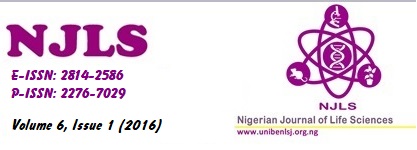BIOACCUMULATION OF COMMONLY DETECTED METALS IN THE SILVER CATFISH (CHRYSICHTHYS NIGRODIGITATUS) COLLECTED FROM MAKOKO RIVER, LAGOS NIGERIA
DOI:
https://doi.org/10.52417/njls.v6i1.311Keywords:
Pollution, Metals, Bioaccumulation, Chrysichthys nigrodigitatus, Gill, LiverAbstract
This study investigated the bioaccumulation of selected essential and non essential
metals in the silver catfish (Chrysichthys nigrodigitatus) collected from Makoko River,
dead end of the Lagos Lagoon. Concentrations of Iron (Fe), Lead (Pb) and Calcium
(Ca) were found to be higher in liver of Chrysichthys nigrodigitatus with mean values
of 34.52± 6.52 mg kg-1, 1.02± 0.16 mg kg-1and 63.45± 8.62 mg kg-1respectively
compared to concentrations detected in its gills with mean values of 32.64± 5.71 mg
kg-1, 0.10± 0.01 mg kg-1 and 41.58± 6.56 mg kg-1 respectively. While concentrations
of Copper (Cu), Manganese (Mn) and Magnesium (Mg) were found to be higher in its
gills with mean values of 2.09±1.61 mg kg-1, 1.79±1.84 mg kg-1, and 12.84±11.90 mg
kg-1respectively compared to concentrations detected in its liver with mean values of
0.74±0.53 mg kg-1, 1.79±0.94 mg kg-1 and 8.36± 4.67 mg kg-1 respectively. The
concentrations of the metals in the tissues were found to be higher than respective
concentrations detected in water or sediments of the fish habitat indicative of
bioaccumulation. Concentrations of light metals Ca and Mg were also observed to be
higher than concentrations of heavy metals Fe, Pb, Cu and Mn in the tissues of the
fish species. Bioaccumulation of metals in tissue of edible fish species can have
deleterious effects on nutritional values of the fish and also pose a public health
threat to final consumers. The need for continuous monitoring of levels of harmful
pollutants in water bodies and edible aquatic species supported.

Published
Issue
Section
License
Copyright (c) 2016 https://www.unibenlsj.org.ng/index.php/njls

This work is licensed under a Creative Commons Attribution 4.0 International License.





